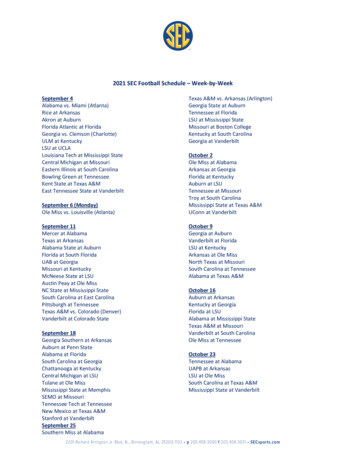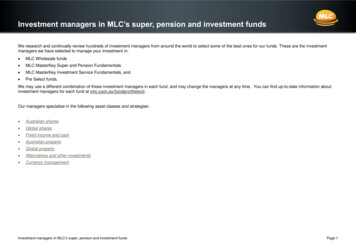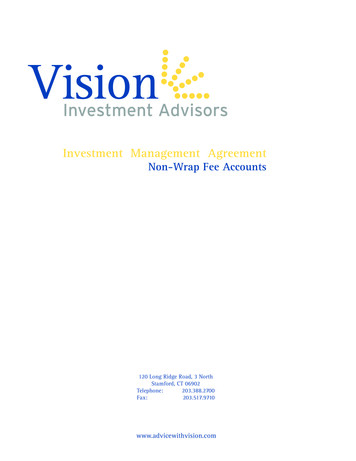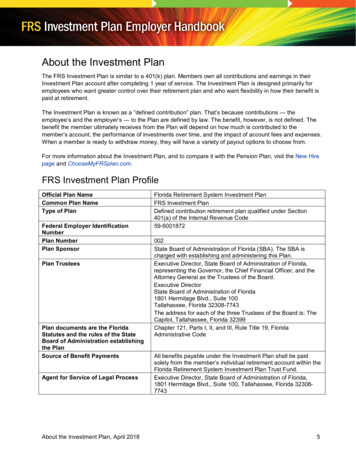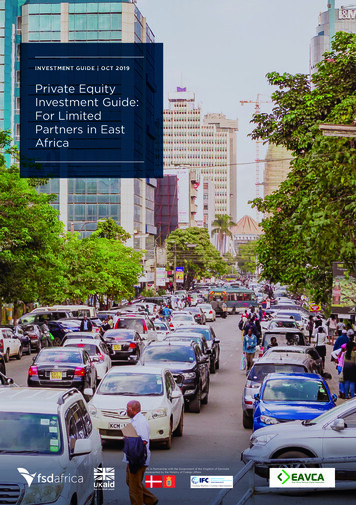
Transcription
INVESTMENT GUIDE OCT 2019Private EquityInvestment Guide:For LimitedPartners in EastAfricaIFC in Partnership with the Government of the Kingdom of Denmarkrepresented by the Ministry of Foreign Affairs
Private Equity Investment Guide: East Africa East African Venture Capital Association (EAVCA), Financial Sector Development Africa (FSDAfrica), International Finance Corporation (IFC) – collectively referred to as the ‘Private EquityInvestment Guide: For Limited Partners in East Africa Publishers’.All rights reserved. This publication may be reproduced, stored in a retrieval system, ortransmitted in any form or by any means, electronic or mechanical, including photocopying,recording or otherwise provided it is used only for education purposes and is not for resale, andprovided full acknowledgement is given to the stakeholders as the original publishers.The Publishers make no representations or warranties whatsoever as to the accuracy,completeness or suitability for any purpose of the content; nor shall they be liable for anyspecial, incidental, indirect or consequential damages of any kind arising out of or in connectionwith the use of this content. Descriptions of, or references to, products or publications does notimply endorsement of that product or publication.
Private EquityInvestment Guide:East AfricaOCTOBER 2019
Acronyms & AbbreviationsDFIDevelopment Finance InstitutionsEAVCAEast Africa Venture Capital AssociationESGEnvironmental, Social and GovernanceFSDAFinancial Sector Deepening AfricaFOFFund-of-FundsICInvestment CommitteeIFCInternational Finance CorporationILPAInstitutional Limited Partners AssociationIRRInternal Rate of ReturnIMAInvestment Management AgreementGPGeneral PartnerLPLimited PartnerLPALimited Partnership AgreementLPACLimited Partner Advisory CommitteeNPVNet Present ValuePEPrivate EquityPIPEPrivate Investments in Public EquitySAAStrategic Asset AllocationSHAShareholders’ AgreementSMESmall-to-Medium EnterprisesVCVenture Capital
AcknowledgementsThe publishers would like to thank all industry professionals whose expertise andinsights were sought during the making of this Investment Guide, including theRisCura team and Solomon Wifa of Wilkie Gallagher and Farr.The publishers are also appreciative of the East Africa Venture Capital Association,the FSD Africa Financial Markets and Communication team, and IFC PrivateEquity team, who coordinated, conceptualised, designed and, alongside theRisCura team, developed this Investment Guide.
List of ContentsExecutive Summary 81Introduction 91.1What is private equity? 91.2What is private debt? 101.3Private investments in public equity 2The merits of Private Equity as an asset class 132.1Private equity fund structure 162.2Private equity fund-of-funds structure 172.3Preferred return and waterfall distribution 213Understanding the Role and Responsibility of the Limited Partner 253.1Who are the Limited Partners? 253.2The role of the limited partner advisory committee 253.3Structure of the LPAC 263.4Capital calls 273.5Establishment costs 284Understanding the Role and Responsibility of the General Partner 314.1Who are the General Partners? 314.2Investment guidelines 314.3The investment committee 324.4GP capital commitment 324.5Removal of the GP 334.6Key person risk 344.7Performance reporting 344.8Private capital strategies – stages of financing11 36Glossary of Investment Return Terminology 39Glossary of Investment Valuation Methods 40Glossary of Private Equity Terms 42
List of figures and tablesFigure 1: Private debt strategies and their common risk/return profiles 11Figure 2: Private equity J-curve 15Figure 3: Private equity fund structures 17Figure 4: Private Equity Fund-of-Funds Structure 17Table 1: Return and distribution 21Table 2: Stages of financing 36
Investment Guide IntroductionExecutive SummaryThis Private Equity Investment Guide has been developed with the East Africanpension fund trustees in mind. It acknowledges that the role of trustee is increasinglycomplex. When faced with ever more investment products, the complexity lies inassessing whether they are appropriate for their respective pension schemes.While in most cases trustees appoint specialist service providers to assist in thedelivery of their fiduciary duty, a trustee remains ultimately responsible for thedirection and final decisions of the pension scheme.As East African trustees contemplate whether to invest in private equity as anasset class or to develop their investment policy documents to allow them toinvest in private equity, it should be noted that the average trustee undertakessuch decisions in addition to their day-to-day occupations; they do not engage inthis nascent asset class as specialists. Therefore, to fully appreciate the challengesand opportunities that will become available when allocating to private equityas an asset class, trustees must also appreciate that such challenges andopportunities will be quite different from those they have been exposed to withtraditional asset classes.The Investment Guide has been created to enable the average trustee to haveappropriate background knowledge and understanding of the salient features ofinvesting in private equity. The guide should therefore be used as a learning andreference tool by trustees, empowering them to proactively consider investingin the asset class. In addition, the guide will be useful in the ongoing monitoringand evaluation of their investment decision. Furthermore, the content within thisInvestment Guide has been collated knowing that the average trustee is not anexpert with extensive investment and private equity expertise. Rather, the referencematerial was compiled to empower trustees to ask the necessary questions andto exercise good judgement in their deliberations when contemplating privateequity investments.The Investment Guide has been organised to provide enough content to enablethe average trustee to have sufficient working knowledge of basic concepts,investment principles, governance roles and responsibilities, to guide them intheir decision-making as fiduciaries.In conclusion, this guide marks an important milestone for stakeholders with a keyinterest in seeing the establishment and growth of private equity as an asset classin East Africa. The partnering firms EAVCA, FSD Africa and IFC acknowledge andthank the RisCura team for the information gathering and documentation, whichresulted in publishing this Private Equity Investment Guide.8
Investment Guide IntroductionIntroductionSection 1Introduction
Investment Guide Introduction
Investment Guide IntroductionThis Investment Guide has been compiled to provide practical, industry-ledinformation, with the primary audience being the average East African pensionscheme trustee.It aims to address the following primary areas of enquiry for the averagescheme trustee:Understandingthe asset classand where it sitsalongside otherasset classesWhy and how toinvest in the assetclassAn overview of thebenefits and risksof investing in theasset class1.1 What is private equity?‘Private equity’ is the term typically used to describe a long-term investmentin private, unlisted companies.The investor (in most instances) secures an equity or quasi-equity stake(minority or majority) in the company in return for the investment made.Equity involves the purchase of common shares, while a quasi-equitystake ranges from preference shares, mezzanine debt and other forms offinancial instruments that may be recovered as a revenue share, marginshare, operating debt or dividends, or other self-liquidating instruments.The vehicle for investing is typically a private equity or venture capitalfund. A fund manager or sponsor assumes the responsibility of investingon behalf of the fund investors by means of a fund structure (see section5.1). Fund investors are usually development and other financial institutions,endowment or pension funds, insurance companies and family offices.9
Investment Guide IntroductionPrivate equity encompasses a variety of strategies including venture capital,growth capital, private debt, distressed opportunities and leveraged buyout. The majority of funds in Kenya and Africa are expansionary capitalfunds, where the capital investment is targeted at the expansion ofcompanies that demonstrate the need for capital to grow their establishedbusiness models. This is in contrast to venture capital funds that targetrelatively unproven business models with potential for steep growth onuptake in the market.1.2 What is private debt?The term ‘private debt’ generally refers to debt or credit instruments that are notnecessarily originated by commercial banks, nor are these instruments publiclytraded. Private relates to the fact that the instrument is not traded publicly, asopposed to referring to the issuer of the instrument. Public and private entitiescan issue non-public debt. Private debt instruments are typically used to financebusiness growth, providing working capital to investee companies.Private debt funds come in varied forms and pursue a wide range of investmentstrategies with differentiated risk/return profiles. Such funds invest in instrumentsthat include, but are not limited to, senior secured instruments, subordinated andunsecured debt instruments, mezzanine debt instruments, preference shares andsuch other yielding instruments.The global financial crisis precipitated the growth of the asset class, due tostricter capital adequacy requirements and market dynamics (in general) thatled to banks reducing their willingness to hold on to specific types of commercialloans. This has allowed for the growth of private debt/credit funds to enter thisspace. Demand from institutional investors for private debt as an asset class hasgrown due to the extended period of low interest rates experienced primarilyin the developed markets. As investors have looked to other avenues for higheryield and diversification in their strategic asset allocations, private debt hasbecome increasingly prominent. The asset class presents investors with accessto growing unlisted businesses, through an avenue where return profile is morecertain in comparison to private equity. Investors should appreciate that the assetclass remains nascent in Africa.The multiple types of private debt strategies and their common risk/returnprofiles are shown below in Figure 1.10
Investment Guide IntroductionFigure 1: Private debt strategies and their common risk/return profilesHighMezzanine DebtInvestment Return r DebtSenior directLending2nd Lien debtSenior RealEstate DebtInfrastructureDebtLowLowHighInvestment Risk Continuum1.3 Private Investments in public equityA private investment in public equity (PIPE) is a transaction where one or moreinvestors purchase securities directly from a public company by way of a privateplacement. As a result, such securities purchased through a PIPE transactionwould be considered ‘restricted securities’, where the purchaser of the securitieswould not be allowed to immediately re-sell the securities to the public.11
Investment Guide IntroductionNotes12
Investment Guide IntroductionThe Merits of PrivateEquity as an Asset ClassThe Merits of PrivateEquity as an Asset ClassSection 2
Investment Guide Introduction
Investment Guide The Merits of Private Equity as an Asset ClassThe risks and rewards associated with investing in private equity as an assetclass should be considered within the same risk versus reward framework of anyother asset class. For pension funds, private equity would fall into the broader‘Alternative Investment’ allocation portion of the pension fund’s strategic assetallocation (SAA).Alternative investments are investments that are not part of the traditional threeasset types of listed equity, bonds or cash. Alternative investments can be anythingfrom hedge funds to private equity investments, to real estate, to emerging marketinvestments, that do not fit into one of the traditional asset classes.Alternative investments provide investors with exposure to markets and investmentstrategies that cannot be accessed through traditional fixed income and listed equitymarkets. In addition to attractive risk-adjusted returns, alternative investments allowclients to diversify their portfolios by investment strategy, portfolio manager, industrysector, geography and liquidity needs.However, these non-traditional asset types each come with a different set of riskscompared to their more traditional counterparts. Therefore, when consideringthe addition of alternative investments into a portfolio, their unique and explicitrisks should be considered. Private equity as an asset class has several specificcharacteristics that are unique to this asset class, which should be carefully judgedwhen establishing a private equity investment policy and programme.When a private equity investment programme is executed well, the potential forpositive externalities and significant returns subsists. By definition, private equityis an active investment strategy (General Partners must be hands-on) in orderto deliver on the investment thesis of building better and more valuable unlistedbusinesses. This active investment endeavour also results in positive externalities,that include job creation, a broader tax base and sustained economic growth.Investing in a private equity fund (which consists of underlying unlisted portfoliocompanies) involves a degree of business and financial risk that can result insubstantial losses1. The performance of prior investments is not indicative ofexpected future results. This caveat is equally applicable to private equity as anasset class, as it is to other asset classes. Risk factors that a potential investorin a private equity fund should consider prior to investment include, but are notlimited to, the factors discussed below.The cited risks as they relate to private equity are as applicable to public market assets. However, investorsmust appreciate that private equity introduces illiquidity which, by definition, should not be as material a riskwith public market assets under normal trading conditions.113
Investment Guide The Merits of Private Equity as an Asset ClassRISK FACTORS TO BE CONSIDEREDReliance on portfolio company managementEach underlying portfolio company of a private equity fund is managed on a day today operational basis by each portfolio company’s respective management team.Although the private equity fund is responsible for monitoring the performanceof each investment, there can be no assurance that the underlying managementteam of a portfolio company, or any successor, will be able to manage andoperate each portfolio company in accordance with the private equity fund’splans. Portfolio companies may lack experienced management as well as a strongboard of directors. To counter this, the strategy of the fund manager is to identifyareas of value addition within the portfolio companies, which may include thereplacement of management and operational staff where needed, as measuresused to improve operations and profitability.If the portfolio companies in which a private equity fund invests are not able toretain managers with enough business experience and skills, these companiesmay not be successful, and returns to investors may be adversely impacted.In addition, a portfolio company’s operational and strategic direction may behighly dependent on its founder or other executive leadership. The occurrenceof an unexpected event that deprives a portfolio company of such leaders mayhave an adverse effect on the portfolio company and, in turn, on the value of theprivate equity fund’s investment therein.Lack of diversificationMost private equity funds invest on average in eight to ten businesses, duringa three-year period. This results in a large concentration in specific businessesand in a specific phase of the business cycle. Although this risk can be partiallymanaged by investing across multiple funds and vintages2, residual risk remains.Illiquid and long-term investmentsAlthough a private equity fund’s investment in its portfolio companies mayoccasionally generate some current income, the return of capital and therealisation of gains – such as dividends and interest income – from an investment,generally will occur upon the partial or complete disposition of such investment.While an investment may be disposed of at any time, it is not usually expectedthat this will occur until at least a few years after the investment is made.Vintage refers to the year a fund is initially formed and/or the year in which it initially draws down on capital.The investment performance of funds can therefore be compared, based on the vintage years of each fund.214
Investment Guide The Merits of Private Equity as an Asset ClassPension schemes should therefore take into consideration the following criticalaspects when contemplating investments in private equity funds:When plotted against time (depicted below in Figure 2), the pensionscheme’s cashflows reflect the pattern on initial drawdown(s) on capitaland later distributions. This feature receives the often cited ‘J-curve’ effectsynonymous to private equity investing.Figure 2: Private equity J-curveUSD 200,000,000USD 150,000,000USD 100,000,000USD 50,000,000USD -USD -50,000,000USD -100,000,000USD -150,000,000Cumulative private equity fund cash flows2 per. Mov. Avg. (Cumulative private equity fund cash flows)Private equity as an asset class requires investors to invest a pre-agreedamount of capital or commitment, which subsists (in general) over the lifeof the fund.Minority or joint venture investmentsA private equity fund may hold a minority interest in certain portfolio companiesand, therefore, may have a limited ability to protect its position against adversedecisions taken by the majority interest holders.A private equity fund may pursue investments with strategic investors or jointventures. Such investments may involve risks in connection with such third-partyinvolvement, including:the possibility that a co-investor may have financial difficulties resulting in anegative impact on such investmenteconomic and/or business interests or goals that are inconsistent with thoseof the private equity fund15
Investment Guide The Merits of Private Equity as an Asset Classthe third-party investor may be in a position to take (or block) action ina manner contrary to the private equity fund’s investment objectives. Inaddition, the private equity fund may in certain circumstances, be liable forthe actions of a third-party investor.Manager selection and disparity of returnsDue to the concentration in exposure to specific businesses and a much largerinvestment universe, private equity funds’ returns are much less predictablethan those of listed and credit managers, introducing additional risk to theinvestment portfolio.The selection of high-quality private equity fund managers is a key driver to theultimate success of a pension scheme’s private equity investment programme. Dueto the hands-on or active-management requirement of the asset class, the extentand depth of skills required to assure successful initial due diligence, investmentmonitoring and ultimately, an exit, are all equally important. This dynamicpresents a clear risk to the ultimate returns generated from investing in privateequity as an asset class. This therefore underscores the need and importance forpension schemes to conduct comprehensive and exhaustive due diligence onprivate equity fund managers prior to making the decision to commit capital. Theinvestment track record of the fund manager and its principal team members is astrong indicator of their ability to choose great investments and exit with returnsto investors. This type of due diligence requires pension schemes to either havethe experience internally, or to have the access to specialist third-party serviceproviders for advice and consultation. It is also prudent for pension schemes toundertake their due diligence in consultation with, or parallel to, the due diligenceinvestigations conducted by other experienced investors.ValuationAs the assets are not traded on a listed market and transactions in the securitiesare infrequent, the valuation of the assets is complex and subject to significantjudgement. The valuation of the private equity portfolio flows into the fair value ofthe fund, which is used for transactional purposes and to calculate performance.2.1 Private equity fund structurePrivate equity fund structures differ by region and country according to locallegal considerations but are set up to achieve tax transparency for investors, aswell as legal liability to protect fund investors.A typical structure would work as depicted below:16
Investment Guide The Merits of Private Equity as an Asset ClassFigure 3: Private equity fund ERALPARTNERINDIVIDUAL(LIMITEDPARTNER)PENSION FUND(LIMITEDPARTNER)PE FoF(LIMITEDPARTNER)PE FUNDADVISORINVESTMENT A(COMPANY)INVESTMENTCOMMITTEEINVESTMENT B(COMPANY)INVESTMENT C(COMPANY)The fund vehicle itself is normally set up as a limited partnership or trust, butin certain countries a company is used. The investors in a limited partnershipstructure are referred to as Limited Partners, while the investment manager isreferred to as the General Partner (GP).The GP and/or fund manager to the fund performs the fund managementduties, and seeks and screens investments, conducts due diligence and preparesinvestment proposals to the investment committee. The investment committeetypically includes members of the fund manager’s team as well as externalexperienced investment professionals, and approves deals. Institutional investorsdo not form part of the investment decision-making or fund management butmay be appointed to an advisory committee, known as the Limited PartnersAdvisory Committee (LPAC). The LPAC is typically responsible for making surethe governance aspects of the fund are adhered to and no conflicts of interestoccur, of either the GP, the fund’s investors or other related parties.2.2 Private equity fund-of-funds structureFigure 4: Private Equity Fund-of-Funds StructureINVESTORSFUND OF FUNDS VEHICLEPE FUNDPE FUNDLPAPE FUNDPE FUNDINVESTMENT/INVESTEE COMPANIES17
Investment Guide The Merits of Private Equity as an Asset ClassThe multi-manager, or fund-of-funds (FOFs) option is designed to reduce someof the single manager risks and have experts take over the daily governance, fundconstruction and manager interaction, on a mandate from the fund.Private equity FOFs tend to have uniform and in-depth dedicated managerassessment, and both operational management and risk managementprocesses tailored to the intricacies of the sector. This includes appropriatelymanaging cash flows between drawdowns of capital commitments anddistributions of investment returns over multiple funds and vintages.The main disadvantage with investing in private equity via an FOF is the additionalfee structure for the service, which can often involve both a management and aperformance fee. These fees are in addition to the existing fees that need to bepaid to the underlying private equity managers in the portfolio and can reducethe ultimate returns to the investor. In addition, investing via an FOF removes theinvestor from the direct relationship with the underlying managers.Fund agreementsFor private equity funds established using the traditional limited partnershipstructure, the key document governing how the fund shall be run, and therelationship between the primary parties (GP and LP), is the Limited PartnershipAgreement (LPA).In the case of funds established as companies, the governingagreements are the company’s constitution and the shareholders’ agreements(SHA) between the investors, the fund manager or sponsor and the company.The LPA (or, in the case of a corporate structure, the SHA) is the foundationaldocument that legally binds the relationship between the investors or LPs withina private equity fund and between the LPs and GP of a private equity fund.Salient terms and conditions enclosed within the LPA or SHA include:Rights, obligations and recourse available to all parties who are admittedto the fundThe formation, operation and termination of the fundFees, fund expenses and organisational costsRemoval of the GP or fund managerFundamental commercial issues (such as investment policy of the privateequity fund; management and carried interest fees; constitutional andadministrative matters; risk and performance reporting requirements andparameters)Compliance issues such as environmental, social and governance (ESG)matters and restricted investments (for example, no investment by thefund in businesses involved in production of ammunition or tobacco etc.).18
Investment Guide The Merits of Private Equity as an Asset Class2.2.1 Commitment and drawdown modelThe life of these funds is finite and typically around 10 to 12 years. During thisperiod, the fund manager must source transactions, make the investments, growthose companies over a holding period of three to five years and sell them for aprofit. Investors will have decided on their allocation to the fund at its inception(commitment). This commitment is legally binding, with the investor obliged toprovide the amount committed, as and when the fund manager calls for cash tofund investments for the fund.The capital allocated to a private equity fund is not paid into the fund on dayone but is drawn down into the fund as required to make investments and paymanagement fees. A normal arrangement is that the private equity fund candraw down capital for new investments during the investment period, but afterthat cannot make new investments. The investment period is typically the firstthree to five years.2.2.2 FeesIn the main, investors in private equity funds will experience two primary fees:Management fees – to pay for the day-to-day costs of operating a privateequity fund.Carried interest – The proportion of fees earned by a fund manager, uponsucessfully meeting the hurdle rate of their fund performanceManagement feesManagement fees are usually charged as an annual percentage of an investor’scommitted capital during the investment period (generally the first three to fiveyears of a fund). These fees cover the cost of running the fund, most often between1.5% and 2.5% per annum, with most of the funds charging 2% per annum.Best practice calls for the GP to provide the prospective LP(s) with a transparentbudget (prior to launching a fund), where the LPs can independently adjudicatethe reasonability of the proposed fee model.The extent of the fee depends on the size of the fund and the resources requiredto implement the fund’s strategy. For example, private equity funds targetingthe small-to-medium-sized business market segment (SMEs), generally will incurhigher costs to service this nascent market segment; as a result, the management19
Investment Guide The Merits of Private Equity as an Asset Classfee for such funds will usually be slightly higher than private equity funds thattarget the mid-market or established large business market segments. SMEtargeting funds will usually peg their fees in the region of 2% to 2.5% per annumin comparison to funds targeting more established/mature/later-stage businesscycle market segments, charging between 1.5% and 2% per annum. It is now alsocommon practice for fees to step-down as commitment size increases, as well asfees being reduced over time as a fund heads towards maturity.Carried Interest or performance feesPerformance fees are usually a fixed percentage of the fund’s gains (generallybetween 10% and 20%, but most often 20%). The term ‘carried interest’ is oftenused interchangeably with performance fees. The European method of carriedinterest applies the concept of carried interest being paid out on a whole fundbasis (i.e. only once the LPs have received back their entire capital contributed tothe fund plus their preferred return). The preferred return is the return rate thata fund must exceed before carried interest payments are made to the GP. It iscommon to see preferred returns being set in the region of 8% per annum.For example, in a simplified fund:The LP has contributed 100 of capital and the GP 10 (10%) of capital.The LP has also contributed 4 in fees (GPs generally do not pay fees onthe capital they commit). If we assume that the fund invested in a singleinvestment and returned either 90 (0.9x capital), 100 (1x capital) 120(1.2x capital), 125 (1.25x capital), 130 (1.3x capital) or 135 (1.35x capital),the returns would be allocated as follows:If the fund returns 90both the Limited Partners’ and General Partners’ capital is returned inproportion: the LP receives 100/110 x 90, while the GP receives 10/100 x 90.Thus, the LP receives 81.80, while the GP receives 8.20.If the fund returns 120normally the capital is returned first, then the LP receives an amount equal tothe fees it paid. A preferred return of 8% is allocated to the LP. Thus:First capital is returned of 100 to the LP and 10 to the GP. This allocates 110 of the returns.Next, an amount equal to the fees is allocated to the LP, thus allocating 4 to the LP.20
Investment Guide The Merits of Private Equity as an Asset ClassIf the investment period was 1 year and the fees were drawn down at thebeginning of the year, an additional 8.32 needs to be allocated to the LPto ensure that the LP has earned their preferred return of 8% on both thecapital and fees amounts. This results in a total of 112.32 being allocatedto the LP and 10 being allocated to the GP. As the total return is 120, 10 is allocated to the GP and 110 to the LP.If the fund returns 150the performance fees become relevant. If the GP earns 20% performance fee,they will n
interest in seeing the establishment and growth of private equity as an asset class in East Africa. The partnering firmsEAVCA, FSD Africa and IFC acknowledge and thank the RisCura team for the information gathering and documentation, which resulted in publishing this Private Equity Investment Guide. 8





